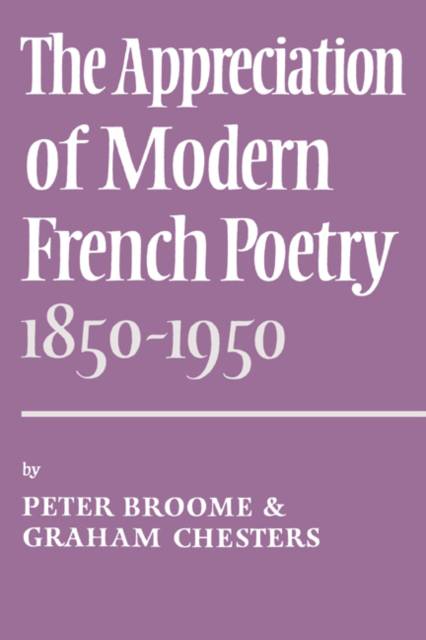
- Afhalen na 1 uur in een winkel met voorraad
- Gratis thuislevering in België vanaf € 30
- Ruim aanbod met 7 miljoen producten
- Afhalen na 1 uur in een winkel met voorraad
- Gratis thuislevering in België vanaf € 30
- Ruim aanbod met 7 miljoen producten
Zoeken
The Appreciation of Modern French Poetry (1850 1950)
P Broome, Graham Chesters, Peter Broome
Paperback | Engels
€ 73,95
+ 147 punten
Omschrijving
Biographies of poets are often rich in human interest; manuals of literary history can be full of broad insight and suggestive parallels. But it is all too easy to let the study of French poetry drift towards lives, loves and -isms and away from the appreciation of its supremely creative use of language. Born of the belief that the proper study of poetry is the poem itself, this book seeks to concentrate on the poetic process at work on the page. Its aim is to encourage the student and the general reader to penetrate the textual richness of modern French verse where verbal artistry combines so powerfully with imaginative vision. The full introduction deals with such questions as metre and rhythm, uses of verse-form, sonority, imagery and structure, studying them not in the abstract but in particular, 'living' contexts. This leads on to detailed commentaries on individual poems illustrating, after the consideration of the problems of reading poetry in general, how one might approach poems as artistic unities in their own right. These guided commentaries are essentially an invitation to the reader to explore certain paths into the poem for himself. They do not provide a wrapped, sealed and delivered explanation; they call for and depend upon the reader's active involvement. Both the illustrations of the introduction and the commentary texts are taken from the fourteen poets who feature in the companion volume to this work, An Anthology of Modern French Poetry. In this way a complete overlap is created, and one is invited to pass from preliminary exercises in appreciation into the wider, more stimulating world of a fully balanced anthology.
Specificaties
Betrokkenen
- Auteur(s):
- Uitgeverij:
Inhoud
- Aantal bladzijden:
- 180
- Taal:
- Engels
Eigenschappen
- Productcode (EAN):
- 9780521209304
- Verschijningsdatum:
- 15/07/1976
- Uitvoering:
- Paperback
- Formaat:
- Trade paperback (VS)
- Afmetingen:
- 152 mm x 229 mm
- Gewicht:
- 272 g

Alleen bij Standaard Boekhandel
+ 147 punten op je klantenkaart van Standaard Boekhandel
Beoordelingen
We publiceren alleen reviews die voldoen aan de voorwaarden voor reviews. Bekijk onze voorwaarden voor reviews.








